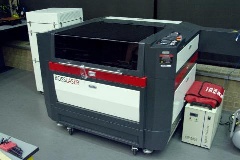Manufacturing
A majority of the mechanism itself was made by laser cutting 1/4" thick wood. The frame, links, and the slider was made using this wood. The base of the mechanism as well as the slider walls were made of 3/4" thick plywood. 5/16" diameter wooden rods, washers, and 3/4" diameter wooden plugs were used to make the pin joints. For the slotted link, a special brace was made to keep the slider from wiggling on the stationary rod. Super glue as well as wood glue was used for places that could not be screwed together.
Manufacturing





Assembly
Two frame pieces were screwed together to strengthen the mechanism, the frame was then screwed to the base. The holder for the input rod and the holder for the stationary rod were placed at an appropriate distance from each other and glued to the frame pieces and allowed to cure.
Figure 1: Placement of Holders on Frame
The input link was glue to a rod to serve as the method of inputting the rotational motion. Joints between links were made using the following method:
Figure 2: Joint Assembly
As seen above, a sanded rod was used as the joint. At one end of the rod a plug was glued then the rest of the joint was assembled in this order: washer, one link, washer, other link, washer. At the other end of the rod, another plug was placed leaving very little free space on the joint rod to allow the links to rotate on the rod. As stated before, a special brace was made for the slotted rod. This brace was placed to prevent the slotted link from moving along the stationary rod. The design was as follows:
Figure 3: Special Brace Design
After all the links were connected, before the slider was attached, the slider walls were placed. Slider wall were made from the 3/4" thick plywood and screwed on the base. The slider was made of the 1/4" thick wood and connected in a similar manner to the other joints. However, due to the load a counter-weight was placed on the other side of the rod to prevent the slider from reducing the range of motion.